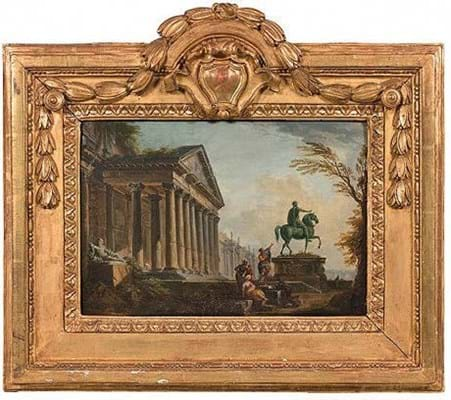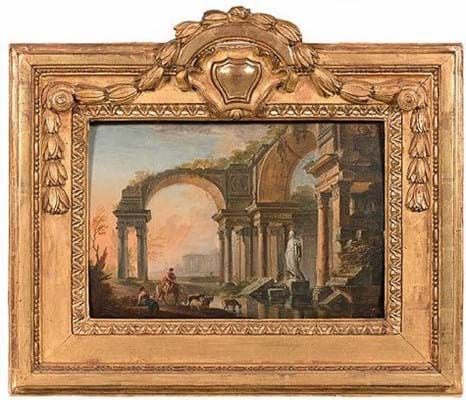One doesn’t quite know what to expect when dropping into William Thuillier’s gallery at his home in Pimlico, London.
During lockdown our visit to the veteran art dealer and broker’s abode is, of course, virtual. Yet even over a Zoom call, the unconventional side of Thuillier and his business model becomes clear.
First, there’s Thuillier’s dog Henry to contend with. In normal times, Henry’s penchant is to “hump everything, including clients’ legs when they come here to view,” his owner reveals.
Clients are not put off by the attention, apparently, with Henry’s presence making viewings nothing if not more memorable.
Then there’s the task of categorising Thuillier’s market for pictures, with portraits and landscapes from across four centuries spot-lit on his home gallery walls.
Despite starting out as an Old Master dealer back in the 1970s, a much broader spectrum of British and European schools has kept Thuillier in business for more than 40 years.
Last year he sold a John Lavery (1856-1941) oil on canvas of Tangiers Harbour to a private collector.
Another oil on canvas, this time dating to the 18th century, attributed to Joseph Nicholls (1692-1760) and depicting the old Houses of Parliament, was a further highlight sale in 2020.
“As the market expands and contracts, I’ve been happy to deal across a wide range – Old Masters, Impressionists, post-Impressionists and Modern British,” he says.
With his prices starting at under £1000 for an Old Master drawing, they rise to £150,000 for a fresh-to-market work by an important artist.
‘Miss Havisham’s house’
Thuillier’s stock has less to do with trends and more with opportunities to buy, as the story behind the Lavery painting illustrates.
“It was from the same collection as a 19th century French Orientalist painting I have for sale. I found them both in a client’s apartment that was rather like Miss Havisham’s house, looking like they hadn’t been touched in years.
“There they were, the Lavery and the Benjamin-Constant, hanging dustily on the wall… a lovely moment.”
In the transparent age of the internet, how does a dealer continue to make such discoveries?
“The internet has provided new restrictions as well as opportunities,” says Thuillier. “As I no longer have a West End gallery, my purchases are limited to buying something specific for a client, or a sleeper that’s been under-catalogued at auction.
“Most of the paintings I’ve sold in the past few years have been sleepers of this kind, including a portrait of the famous castrato Farinelli by Jacopo Amigoni (c.1685-1752) and a classic landscape by Gaspard Dughet (1615-75), as well as a work by Eugène Delacroix (1798-1863).”
EU still worth it
This quest for fresh stock never stops. France, Italy and Spain remain Thuillier’s Continental hunting grounds, and he is more sanguine than most about the added Brexit red tape. “Buying in the EU is still worth it, as you find such good things at auctions and fairs there,” he says.
Sourcing in Italy has taught Thuillier to view paperwork with patience, as have Covid-19 delays in bringing works from the Continent into the UK.
“Patience is a virtue and you just have to go with the new bureaucracy,” he says. “There’s no point getting worked up about it.
“Yes – moving art from the EU will cost more in shipping, time and taxes but sellers will just have to feed more cost into their price structures to cover this. Like premiums at auction – these costs will end up getting absorbed.”
No longer an exhibitor at major fairs such as Masterpiece, he stepped tentatively back into that arena by taking part in London Art Week Digital last year, liking the experience.
In the meantime, Thuillier notices his buyer profile has changed. “Twenty years ago I had buyers from all over the world, including museums and art galleries, thanks to taking part in fairs.
“But my clients are now mainly British business or landowning types with houses that respond well to traditional pictures.”
Instagram is a great platform for displaying his eclectic range, with the William.Thuillier account having a respectable 650 followers. Posts get “an instant response,” he says.
Email marketing is another crucial way for him to keep in touch – a ‘picture of the week’ feature is popular – especially during lockdown.
Zoom fan
Now that Thuillier is an advocate of Zoom – he credits this ATG interview as the catalyst – does he ever see a time when dealers sell artworks entirely via the video channel that’s such a big part of our daily lives?
“Hmm…I could see that happening,” he says, adding that such a sale would “probably need the caveat ‘subject to a condition report’ or ‘inspection’, as dealers have got to be transparent”.
Slower pace
His hopes for 2021? “To survive! We can’t make predictions as we just don’t know where this wretched disease is going to take us. I don’t think beyond next week – I spent a fortune on cancelled flights last year.”
The slower pace of trade during lockdown “suits me right now,” Thuillier adds. “I’m having a good time reading, researching and following up sales.”
Thuillier’s progress: from West End to Pimlico - via Malibu
Oxford University 1966-69
Though interested in art, William Thuillier studied history at Oxford in the late 1960s, plugging the gap with extra-curricular studies at the nearby Ashmolean Museum.
At Sotheby’s 1969-70
Having won a coveted place on the inaugural Sotheby’s training scheme, the tutor considered Thuillier “an academic and so put me in the book department, from which I escaped as soon as possible”.
Old Master dealing 1974-present
He learned about “the ways of the commercial art world” working as a director of the Alexander Gallery in London’s Duke Street, specialising in Flemish 17th century paintings.
Lecture tour 1981
In the early 1980s Thuillier lectured on art and architecture at London University, the Metropolitan Museum in New York and the J Paul Getty Museum in Malibu.
From West End 1992 to home gallery 2015
From the 1990s-2014, Thuillier was one of several fine art and antiquities dealers with galleries at 14 Old Bond Street generating “a lot of cross fertilisation and a great dynamic”.
In 2014, amid a wave of lease non-renewal by landlords in Mayfair that year, Thuillier was faced with finding new premises. “So I set up at home and the next career phase came together in a fortuitous way.”
Across the ages: three centuries in pictures
1 A classical landscape
Artist: Jan Frans van Bloemen, called Orizzonte (1662-1749)
Sourced in the Italian art market
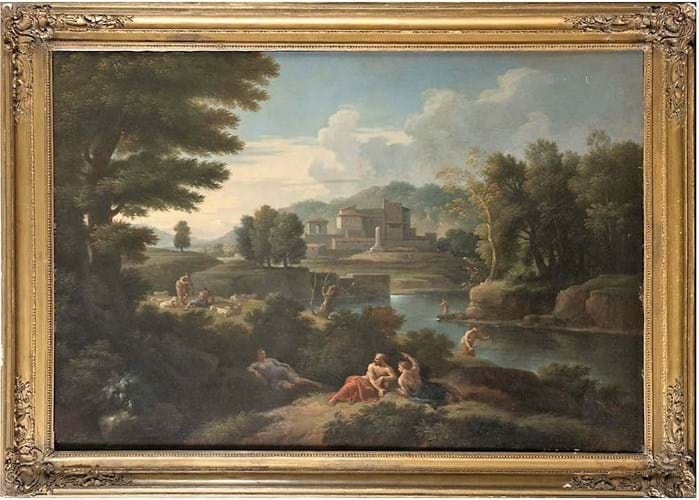
A landscape by Jan Frans van Bloemen, called Orizzonte, available from William Thuillier and priced in the region of £50,000.
Flemish painter Jan Frans van Bloemen, called Orizzonte (1662-1749) was a prolific painter of landscapes, his most successful years spent in Rome where he was patronised by leading local families. The striking blue-greens that characterise his distances led him to be known as ‘Orizzonte’ by his Italian contemporaries, meaning ‘horizon’.
The attribution of this classical landscape to van Bloemen has been confirmed by Old Master expert Prof Giancarlo Sestieri. It features figures reclining beside a river and shepherds tending their flocks, with a fortified villa beyond.
Measuring 3ft 4in x 4ft 6in (1.02 x 1.37m), it is available from William Thuillier priced in the region of £50,000.
2 Charles Seymour, 6th Duke of Somerset
Artist: Sir Godfrey Kneller (1646-1723) and studio
Sourced in the Italian art market
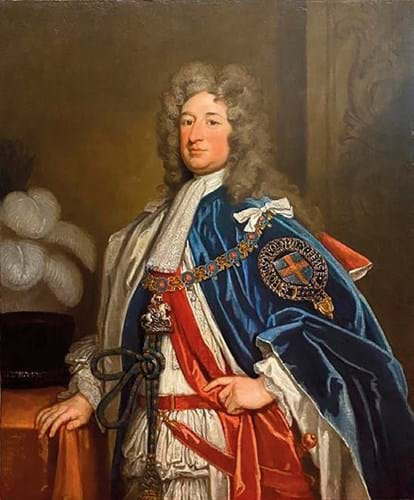
A portrait of Charles Seymour, 6th Duke of Somerset by Sir Godfrey Kneller (1646-1723) and studio, available from William Thuillier and priced in the region of £35,000.
Sir Godfrey Kneller was the pre-eminent portraitist of the late Stuart and early Hanoverian period, serving every sovereign from Charles II to George I as Principal Painter.
One of his most aristocratic sitters was ‘The Proud Duke’, Charles Seymour, 6th Duke of Somerset. Seymour’s first marriage to Elizabeth Percy, daughter of the Earl of Northumberland, brought vast estates and properties.
David Taylor, curator of pictures and sculpture at the National Trust, considers this oil on canvas, measuring 4ft 2in x 3ft 4in (1.27 x 1.02m), to be the work of Kneller, with some studio assistance.
It is priced in the region of £35,000.
3 The Court of Myrtles in the Alhambra
Artist: Jean-Joseph Benjamin-Constant (1845-1902)
Sourced on consignment by descendants of the original purchaser
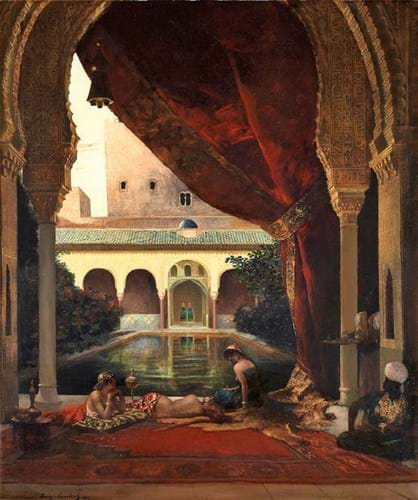
‘The Court of Myrtles in the Alhambra’ by Jean-Joseph Benjamin-Constant, another work available from William Thuillier.
This painting shows the Court of Myrtles in the Alhambra in Granada, with languid figures resting beside a pool, watched over by a seated attendant.
One of Benjamin-Constant’s largest works at 4ft 11in x 4ft 3in (1.48 x 1.18m), the oil on canvas’ rich textures and monumental compositions are central to his mature paintings of the 1870s-80s.
A 2015 exhibition at the Musée des Augustins in Toulouse, where Constant studied, succeeded in re-establishing him as one of the great Orientalist painters of the 19th century, continuing a tradition initiated by Delacroix and Gericault.
His works are found in the Louvre, New York’s Metropolitan Museum and the National Gallery of Canada.
Price on application.



